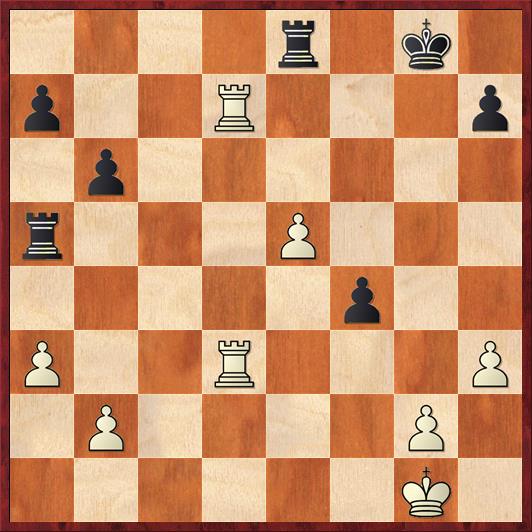Yesterday I wrote about the results of the Aptos Library Kids’ Chess Tournament, which I directed yesterday. I have two followups to that post. First, our local paper, the Santa Cruz Sentinel, had an article about the tournament with some nice photographs (but no results). You can see me at the very, very far left-hand side of one of the photos, the one that shows the whole tournament room.
Second, and probably more interesting to my blog readers, I’d like to show you how the very last game of the tournament ended. This was a position in the playoff game for second place between Andrew Wang (who had White) and Jonathan Zhou (black).
FEN: 4r1k1/p2R3p/1p6/r3P3/5p2/P2R3P/1P4P1/6K1 b – – 0 1
Wang and Zhou had drawn in a very complex game in round two. In fact, that was the same game mentioned in the newspaper article, which continued five minutes past the start time for round three. This game also was very evenly contested, with neither player able to develop much of an advantage. However, there were two reasons that I doubted they would draw this time. First, they were playing at a time control of game in ten minutes. And second, they were in a double-rook endgame, an endgame where the cost of making a mistake can be very high.
I once gave a lecture on these endgames for ChessLecture, and talked about the Golden Rule of Double-Rook Endgames: Never forget that two rooks are mating material. Keep that in mind as you watch the conclusion of this one!
Zhou started with what I think was the best move: 1. … R8xe5. During the game I thought it might be worth capturing with the other rook, because I hated its position on a5. That’s the sort of square you never want to put your rooks on in rook endgames; on a5 it is a completely passive piece, and if you ever try to activate it (which you should) it will immediately cost you a pawn.
Nevertheless, I think that Zhou’s move here was correct, because the rooks work better as a battery on the fourth rank than on the e-file. After 1. … R5xe5 2. Rxa7 Re1+ 3. Kh2 White’s king is completely secure and it looks as if Black has sacrificed a pawn for nothing.
Now Wang played a canny move, 2. Rc7! My first thought was that he was trying to double rooks on the seventh rank, but there is a more elemental threat that Zhou completely missed. He played 2. … Rg5??, which looks like a strange move — but let me remind you that this is an 11-year-old kid playing a high-pressure game with the clock ticking down. Under the circumstances, all mistakes are forgivable. Wang instantly played 3. Rd8 checkmate.
It was such a sudden finish that it took me a moment to grasp what had happened. Here I was preparing myself mentally for a long endgame battle perhaps ending with a time scramble, which I as tournament director would have to play close attention to. But then, bam! The game was over, and the tournament too. I felt bad for Zhou, who had played courageously against an older and probably stronger player, only to lose because one mistake. But that is chess sometimes.
What should Zhou have done instead? Well, obviously he needs to stop either the checkmate or the rook advance to the seventh rank, so he has to block the d-file with one of his rooks. Here I think that the a-rook is the right one because it leaves White with fewer options — and gives Black two very healthy rooks if White declines to trade.
Thus, after 2. … Rad5! I think that Black can very likely save a draw. There are two main points. First, if 3. Rxd5 Rxd5 4. Rxa7, Black wins the pawn back with a totally defensible endgame after 4. … Rd1+ 5. Kf2 (5. Kh2 is no improvement because 5. … Rd2 comes with a threat of … f4-f3) Rd2+ 6. Kf3 Rxb2.
Second, if 3. Rdc3, Black draws with 3. … Rd1+ 4. Kf2 (4. Kh2?? would lose stunningly after 4. … Ree1!, which gives Black an indefensible mate threat. Remember the Golden Rule of Double-Rook Endgames! It can happen to either player!) 4. … Rd2+ 5. Kf3 Re3+! A key resource. With this move, sacrificing a pawn that Black was going to lose anyway, Black trades off a pair of rooks and eliminates any back-rank mating threats. After 6. Kxf4 Rxc3 7. bc Rxg2 White’s pawn formation is too fractured, and I think that Black will be able to draw.
This position reinforces another lesson that I learned from giving ChessLectures. The games of amateurs contain positions just as rich and fascinating as the games of grandmasters. The difference is that the hidden possibilities go unnoticed in the amateur games. Nevertheless, I think there is an important lesson for all amateurs, that learning from the grandmasters can actually pay dividends in your own games. It is precisely in this type of position, which is “halfway between” a draw and a win for White, that an investment in learning the subtleties of chess can pay the greatest dividends.




{ 1 comment… read it below or add one }
Even in amateur games the possibilities sometimes reveal themselves. There was a bit of a buzz at the Washington Open over the 1700-rated girl who, faced with a ghastly Q+R vs Q+R+pawns endgame and mate threats besides, banged down her queen on f2, forcing her opponent to take it with his queen, and then gave perpetual with her rook because any capture stalemated her king on h1. The spectators had no inkling this was going to happen! It was really fun to see such a classic combination in practice.